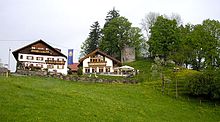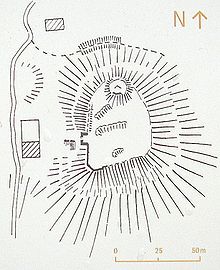Werdenstein Castle
| Werdenstein Castle | ||
|---|---|---|
|
The preserved gate structure (outside) |
||
| Castle type : | Höhenburg, hillside location | |
| Conservation status: | Gate construction, small remains of the wall | |
| Standing position : | Noble | |
| Construction: | Sandstone | |
| Place: | Immenstadt im Allgäu - Eckarts | |
| Geographical location | 47 ° 36 '14.6 " N , 10 ° 14' 41.1" E | |
| Height: | 740 m above sea level NN | |
|
|
||
The ruins of Werdenstein Castle ( Immenstadt im Allgäu , Eckarts district ) are located on a sandstone hill above the Illertal in the Oberallgäu district in Swabia . In addition to small remains of the wall, only the gate construction of the high - to post-medieval castle complex has been preserved.
history
The fortress was the ancestral seat of the Lords of Werdenstein and the Werdenstein lordship . The originally noble sex soon joined the followers of the Kempten monastery . In 1239, Hildebrand von Werdenstein was the first bearer of the name to appear as a witness in a monastery document.
From 1350 onwards, the Werdensteiners served the monastery as hereditary treasurers . a. four houses in Kempten as fiefdoms . At the beginning of the 15th century, however, the family submitted to the House of Austria . Apparently they wanted to achieve greater independence from the prince monastery and also assert themselves against the mighty Counts of Montfort , who sat only a few kilometers southeast on the large double castle Rothenfels - Hugofels .
In 1457 Count Hugo von Montfort besieged the Werdenstein during a feud . In 1464 the Höhenburg appears under the Austrian "Swabian feuds". The Werdensteiners had subordinated their rule to the archdukes and received it back as a fief. In 1491 Hildbrand von Werdenstein was in the service of Maximilian I.
In 1525, the rebels looted the castle during the Peasants' War . The lord of the castle, Georg, fled behind the protective walls of the nearby imperial city of Kempten and recorded the war events in the "Werdensteiner Chronik".
After the family moved to their newly acquired estate Dellmensingen near Ulm in 1659 , the hilltop castle was only inhabited by one administrator. Occasionally the Werdensteiners used their ancestral castle as a summer residence until 1782. In Dellmensingen, Franz Ignaz Albert von Werdenstein (1697–1766) was born as a scion of the family . He was auxiliary bishop of Freising .
At the end of the 18th century, the last Baron von Werdenstein was in financial difficulties and had to sell the castle to the Counts of Königsegg-Rothenfels in 1785 . Anton Christoph von Werdenstein wanted to keep his daughters in control of Dellmensingen. With the baron, the old Allgäu noble family died out in the male line in 1796. His two sons died in childhood.
The Counts of Königsegg themselves had no use for the old noble seat and had the roofs covered a little later. The castle then began to fall into disrepair. In 1804 the Habsburgs acquired rule from the Königseggern.
As early as 1805 the property came to the Bavarian state, which sold the castle ruins to the landowner Gruber in 1821. The new owner exploited the remains of the wall as a quarry . In 1898 the Rapp family bought the site and have been running the farm in front of the castle ever since. In 1988, the owners began renovating the remains of the castle and transforming it into a beer and guest garden in the associated castle café.
description
The freely accessible castle ruins now serve largely as the beer garden of the castle café on the area of the former farm and building yard. The ruins of the fortress were largely removed in the early 19th century. The partially preserved gate tower and the few remains of the foundations in the south were renovated and slightly bricked up in the last decades of the 20th century.
The highest hill in the north carried the dungeon from which around 1825 was still the south wall upright. The area is fenced and inaccessible. According to Nessler's (1985) drawing up of the plan, slight traces of the foundation are still preserved.
The Palas rose formerly on the south side. At the location of the medieval castle chapel under the keep, a small chapel was inaugurated again as part of the renovation work.
The gate construction
The gate tower was formerly accessible from the building yard via a bridge. The modern approach along the castle hill is from a later time.
The tower, which is still around six meters high, was built up from chunks of sand and rubble. During the renovation, it was re-covered and a few layers of stone were added. The corner cuboid consists of larger and more regular stones. The four western firing openings on the two floors are unusual. The sockets were designed for the use of hook bushes and appear as horizontal slots on the field side, but run vertically on the inside. On the narrow sides, a few small, square, inclined openings break through the wall structure.
A memorial plaque (1929) with some data on the history of the castle is embedded above the archway:
Werdenstein castle and rule of
the Imperial Knights of Werdenstein,
first mentioned in 1239. Hereditary treasurer of
the Kempten monastery.
Conquered and plundered in the Peasants' War in 1525. 1787
sold to the Counts of Königsegg-Rothenfels
. Castle 1791 by Schlossgut -
taken beständer Martin Gruber.
Such boards were attached to numerous Allgäu castle ruins in the first half of the 20th century on the initiative of the Kempten mayor and passionate castle researcher Otto Merkt. In the vicinity of the Werdenstein ruins, the building yard to the west of the castle and the castle mill to the north (Fleschermühle) also bear corresponding inscriptions . The information on the stones is not always historically correct.
literature
- Toni Nessler: Castles in the Allgäu. Volume 1: Castle ruins in the Altlandkreis Kempten and Altlandkreis Sonthofen . 1st edition. Allgäuer Zeitungsverlag, Kempten 1985, ISBN 3-88006-102-5 , pp. 154-175.
- Michael Petzet : Sonthofen district. (The art monuments of Bavaria. The art monuments of Swabia, Volume 8). Oldenbourg, Munich 1964.
- Carmen Margherita Di Giglio : Werdenstein. Roman, Nemo Editrice, Milan 2010, ISBN 978-88902507-2-9 .








